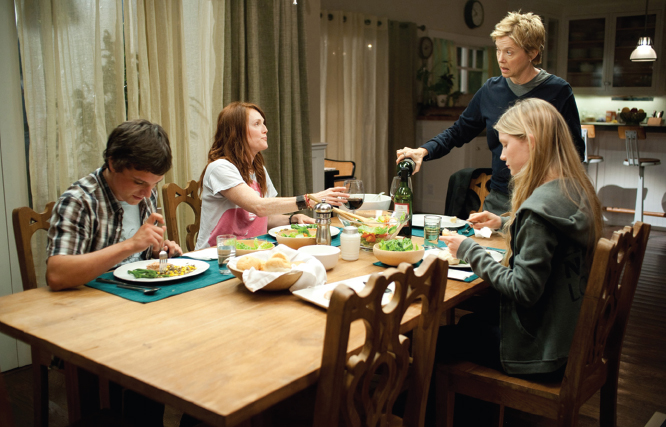Co-Cultures
In the film The Kids Are All Right, mothers Jules and Nic are worried about their teenaged son, Laser, who appears withdrawn. They ask him, over and over, if there’s anything he wants to talk about. They complain that his friend Clay is a bad influence. They ask him for reasons why he sought out his biological father without telling them. But Laser simply does not want to talk. Although such nagging female/noncommunicative male stereotypes are standard in fiction and film, there is some evidence to suggest that, in fact, women are more inclined to voice criticisms and complaints, and men tend to avoid engaging in such discussions.

IN THE KIDS ARE ALL RIGHT, mothers Jules and Nic and their adolescent son Laser play out the typical imbalance of communicativeness between females and males. MANDALAY/SAINT AIRE/10TH HOLE/ANTIDOTE/ THE KOBAL COLLECTION
Differences between men and women reflect one important way that our co-cultures affect how we deal with conflict. Recall from Chapter 5 that co-cultures are the groups we belong to with distinct characteristics or attitudes that unify us and distinguish us from the larger general culture. These distinctions often play out in conflict situations. In a classic study of marital conflict, for example, Gottman (1994) found that women tend to criticize and attack their partner’s character more than men and that men tend to “stonewall” (refuse to engage) more than women. More recent research also suggests that sex and gender influence satisfaction level with regard to certain conflict management strategies. Afifi, McManus, Steuber, and Coho (2009) found that when women perceived that their dating partner was engaging in conflict avoidance, their satisfaction level decreased, but avoidance did not cause the same dissatisfaction in men.
Age is another co-cultural difference that affects conflict. When faced with a potential argument, younger (under forty) and middle-aged (forty to fifty-nine) adults are more likely to openly argue, whereas older adults (over sixty) prefer to use passive strategies, such as “letting it go” or waiting for the situation to change on its own (Blanchard-Fields, Mienaltowski, & Seay, 2007). These avoidance strategies appear to be beneficial, as older adults experience less negative emotion than their younger counterparts when they deal with social tensions passively (Birditt, 2013). Researchers argue that older people may have learned from experience to recognize when an argument is “just not worth it” and that they may be choosing the strategies that help them manage their own emotional well-being (Charles, Piazza, Luong, & Almeida, 2009). For younger and middle-aged adults, however, conflict situations may more often require direct confrontation (for example, at work or in battles with parents), so passive strategies may be ineffective for them at achieving their goals. These confrontations can take a toll: by middle age, the increase in conflict and interpersonal stress appears to have an especially negative impact on people’s well-being (Darbonne, Uchino, & Ong, 2013).
When we think of conflict and culture or co-culture, it is important to remember not to assume that all members of a culture or group reflect the extreme differences. It is also dangerous to assume that differences in culture mean irreconcilable differences in conflict. Competent communication in conflict means understanding and respecting differences while working to “expand the pie” for both parties. Even in the most uncomfortable and frustrating conflict situations, we can learn a great deal about others and ourselves through culture.
AND YOU?
Question
Do you see yourself as more of a feminine or masculine individual? In what ways have gender differences influenced the conflicts you’ve experienced with people whose gender is different from yours?
